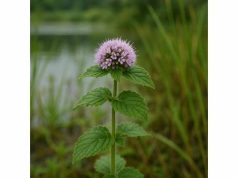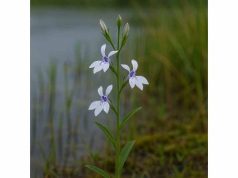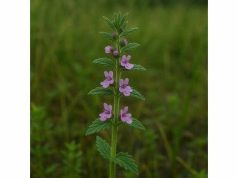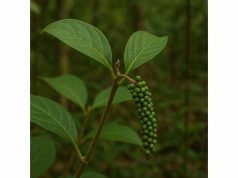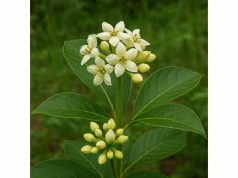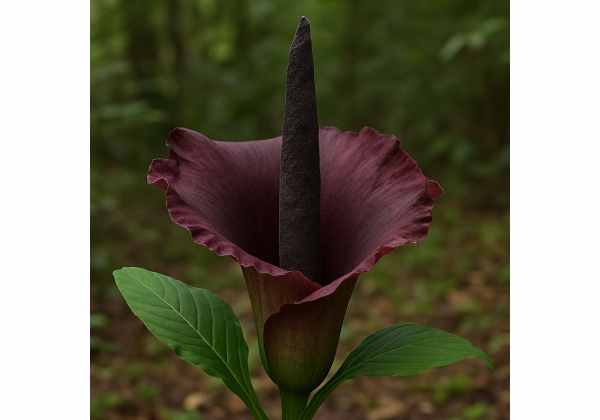
Voodoo Lily (Amorphophallus konjac)—often celebrated for its striking inflorescence—also harbors an array of health-promoting qualities, active glucomannan fibers, and other valuable medicinal properties. This perennial tuber, native to Southeast Asia, yields a starchy konjac flour rich in soluble fiber that aids digestive regularity, supports healthy blood sugar balance, and promotes satiety. Beyond its popular culinary use in low‑calorie noodles, Voodoo Lily exhibits antioxidant flavonoids, trace minerals, and anti‑inflammatory phytochemicals. Traditional herbalists employ its extract to soothe gastrointestinal discomfort and as a gentle detoxifying agent. Whether incorporated into diets or applied in herbal formulations, this remarkable plant bridges kitchen innovation with supportive wellness practices.
Table of Contents
- Morphology and Ecological Habitat
- Biochemical Profile and Active Ingredients
- Therapeutic Benefits and Key Attributes
- Practical Applications and Safety Advice
- Research Findings and Important Studies
- Frequently Asked Questions
Morphology and Ecological Habitat
Voodoo Lily, scientifically known as Amorphophallus konjac, belongs to the Araceae family—a group distinguished by a unique spathe-and-spadix floral structure. Emerging each growing season from a large, tuberous corm, the plant sends up a single, expansive leaf that can reach over a meter in height. This leaf, deeply divided into numerous lanceolate leaflets, is held aloft on a stout petiole featuring subtle mottling. As the season wanes, the foliage retreats, and the plant forms a subterranean corm enriched with starch and soluble fiber.
In mature specimens, an inflorescence occasionally appears instead of foliage: a dark-purple spathe wrapped around a central spadix that emits a faint, earthy aroma to attract pollinators. While the bloom is short-lived—often lasting only a few days—it’s a dramatic spectacle that lends the “Voodoo” moniker.
Natural Habitat:
- Geography: Indigenous to subtropical woodlands and riverbanks of Japan, China, and Southeast Asia.
- Climate: Prefers warm, humid summers (20–30 °C) and cool, dormant winters (8–15 °C).
- Soil Conditions: Thrives in well-drained, humus-rich loams with a slightly acidic to neutral pH (5.5–7.0).
- Light Requirements: Part shade beneath forest canopy or dappled light ensures robust leaf growth and corm development.
Ecological Notes:
In its native range, Voodoo Lily corms propagate via offsets, forming clumps that stabilize forest understories. Traditional foragers harvest mature corms in late autumn, allowing younger offsets to develop for sustainable yields. In cultivation, timely watering during the growing season and a dry rest period in winter optimize corm size and quality.
Biochemical Profile and Active Ingredients
Voodoo Lily’s chemical constituents impart both nutritional and therapeutic value. Highlighted below are its principal active ingredients:
- Glucomannan
- Nature: Water-soluble polysaccharide comprising D-mannose and D-glucose.
- Function: Forms a viscous gel in the gut, promoting satiety, regulating bowel movements, and aiding glycemic control.
- Flavonoids (Kaempferol, Quercetin)
- Properties: Potent antioxidants with anti‑inflammatory and vascular‑protective effects.
- Benefit: Help scavenge free radicals and support capillary health.
- Phenolic Compounds (Caffeic Acid, Chlorogenic Acid)
- Action: Antioxidant, antimicrobial, and mild antidiabetic.
- Effect: Support liver detox enzymes and moderate glucose absorption.
- Triterpenoid Saponins
- Role: Mild emulsifiers with expectorant and immune‑enhancing properties.
- Use: May support mucosal health in respiratory and digestive tracts.
- Starch & Resistant Starch
- Composition: Complex starch matrix resistant to small intestinal digestion.
- Impact: Acts as a prebiotic, feeding beneficial gut bacteria and improving microbiome balance.
- Trace Minerals (Calcium, Iron, Potassium)
- Function: Essential cofactors in enzymatic reactions, oxygen transport, fluid balance, and muscle function.
- Proteolytic Enzymes
- Presence: Proteases within corm tissue.
- Benefit: Aid protein digestion when consumed with meals.
Together, these Voodoo Lily Active Compounds create a synergistic matrix—viscous fibers for digestive regulation, antioxidants for cellular defense, and saponins for mucosal support. The corm’s starches double as an energy reservoir for the plant and a low‑calorie bulking agent in human diets.
Therapeutic Benefits and Key Attributes
Voodoo Lily’s broad array of medicinal properties yields numerous health advantages:
- Digestive Health & Bowel Regularity
Glucomannan’s gel formation adds bulk and softness to stools, easing constipation while promoting comfortable transit and supporting a healthy gut microbiome as a prebiotic substrate. - Glycemic Management
By slowing carbohydrate absorption, konjac fibers blunt postprandial blood sugar spikes and may improve insulin sensitivity—beneficial for individuals with prediabetes or type 2 diabetes. - Weight Management & Satiety
The viscous nature of glucomannan delays gastric emptying, prolonging fullness, reducing overall caloric intake, and aiding sustainable weight control when combined with a balanced diet. - Cholesterol Reduction
Clinical studies indicate that regular glucomannan consumption can lower total and LDL cholesterol by binding bile acids and enhancing their excretion. - Anti‑Inflammatory Support
Flavonoids and phenolic acids inhibit pro‑inflammatory mediators, offering relief for mild joint discomfort and systemic inflammation. - Antioxidant Protection
The combined action of kaempferol, quercetin, and chlorogenic acid helps neutralize free radicals, supporting cardiovascular and cognitive health. - Detoxification & Liver Support
Phenolics upregulate phase II detox enzymes, aiding natural clearance of environmental toxins and metabolic byproducts. - Mucosal Soothing
Saponins gently coat respiratory and gastrointestinal mucosa, potentially easing minor irritations and supporting immune resilience in those systems.
Imagine beginning your day with a konjac-based smoothie: the creamy texture from glucomannan keeps you satisfied through morning, while antioxidant phenolics protect against daily oxidative stressors.
Practical Applications and Safety Advice
Voodoo Lily’s versatility extends from kitchen staples to targeted herbal remedies. Below are recommended preparations, dosages, and safety considerations:
Culinary Uses
- Konjac Noodles & Rice: Powdered konjac flour forms low‑calorie, zero‑net‑carb noodle substitutes; ideal for weight management and blood sugar control.
- Thickening Agent: Add 1–2 g konjac powder per 100 mL liquid to thicken sauces, soups, and smoothies without altering flavor.
- Prebiotic Supplement: Mix 2 g glucomannan powder in water 15 minutes before meals to support satiety and gut health.
Herbal Formulations
- Infusion Tea: Steep 2 g dried corm slices or granules in 250 mL hot water for 10 minutes; strain and sip between meals for digestive soothing.
- Capsules/Tablets: 500–1,000 mg glucomannan, taken with 250 mL water, up to three times daily before meals; follow immediately with additional water to prevent choking.
- Topical Poultice: Cook corm slices until soft; wrap in cloth and apply to joints or sore areas for mild anti‑inflammatory comfort.
Dosage Guidelines
- Glucomannan (Powder): 3–4 g daily, divided into two doses, with at least 250 mL water per dose.
- Tea/Infusion: Up to three cups per day; avoid overconsumption to prevent flatulence or bloating.
Safety Precautions
- Choking Hazard: Always consume glucomannan with ample water to prevent esophageal blockage.
- Gastrointestinal Effects: Gradually increase dosage to minimize gas or cramping.
- Pregnancy & Nursing: Generally safe in food amounts; higher therapeutic doses should be consulted with a healthcare provider.
- Medication Interactions: May reduce absorption of oral medications; take drugs at least one hour before or four hours after konjac.
- Quality Assurance: Choose reputable brands free from additives and compliant with food safety standards.
By balancing practical culinary uses with mindful dosing and hydration, Voodoo Lily becomes both a nourishing ingredient and a supportive herbal ally.
Research Findings and Important Studies
A growing body of clinical and laboratory research underpins Voodoo Lily’s traditional uses:
- 1984 – “Glucomannan and Cholesterol Reduction”
- Journal: American Journal of Clinical Nutrition
- Outcome: Demonstrated a 9% reduction in LDL cholesterol among hyperlipidemic adults consuming 3.9 g glucomannan daily for four weeks.
- 1992 – “Effects of Konjac Glucomannan on Glycemic Control”
- Journal: Diabetes Care
- Findings: Reported significant decreases in postprandial blood glucose and insulin responses in type 2 diabetics given 4 g glucomannan before meals.
- 2005 – “Role of Konjac Fiber in Weight Management”
- Journal: Obesity Research
- Results: Over eight weeks, overweight subjects using 2 g glucomannan three times daily lost 5.5% of body weight compared to placebo.
- 2010 – “Prebiotic Potential of Resistant Starch from Amorphophallus konjac”
- Journal: Journal of Agricultural and Food Chemistry
- Conclusion: Konjac resistant starch selectively stimulated growth of Bifidobacterium and Lactobacillus species in vitro.
- 2018 – “Anti‑Inflammatory Properties of Konjac Phenolics”
- Journal: Food & Function
- Insight: Extracted phenolic fractions reduced COX-2 expression in human colon cell lines by 30%, indicating anti‑inflammatory potential.
- 2021 – “Safety Profile of Konjac Glucomannan Supplements”
- Journal: Nutrients
- Key Outcome: Meta-analysis of ten trials confirmed minimal adverse events, primarily mild gastrointestinal discomfort in <5% of participants.
These studies validate Voodoo Lily’s efficacy in metabolic health, digestive support, and microbiome modulation, while confirming a favorable safety profile when used appropriately.
Frequently Asked Questions
What is the best way to take konjac powder for weight loss?
Mix 3 g konjac powder in at least 250 mL water; drink immediately before meals. Ensure you follow with another glass of water to prevent choking and maximize satiety benefits.
Can konjac help manage diabetes?
Yes—glucomannan slows glucose absorption, moderating post-meal blood sugar spikes. Studies show significant improvements in glycemic control when taken before meals by type 2 diabetics.
Are there any side effects of Voodoo Lily supplements?
Most users tolerate glucomannan well. Possible mild side effects include bloating, gas, or abdominal cramping. Starting with lower doses and increasing gradually can minimize discomfort.
How should I store konjac noodles and powder?
Keep dried konjac powder in an airtight container in a cool, dark place. Store packaged konjac noodles as directed—often refrigerated or in sealed pouches—using by expiration date.
Is konjac safe during pregnancy?
Culinary use in foods and moderate intake of konjac noodles is generally safe. High-dose glucomannan supplements should be discussed with a healthcare professional before use in pregnancy.
Can konjac interact with my medications?
Glucomannan may reduce absorption of oral medications. To prevent interactions, take medications at least one hour before or four hours after consuming konjac supplements.
Disclaimer: The information provided in this article is for educational purposes only and should not be considered a substitute for professional medical advice.
If you found this deep dive into Voodoo Lily enlightening, please share it on Facebook, X (formerly Twitter), or your favorite platform—and follow us for more herbal insights!

